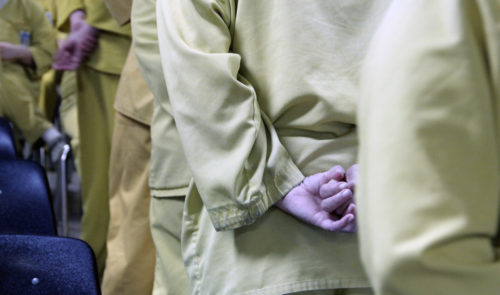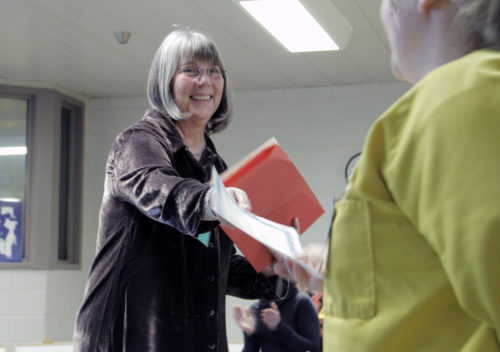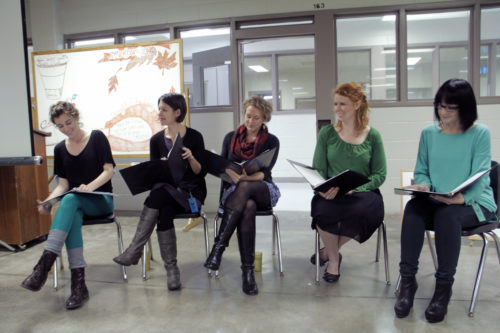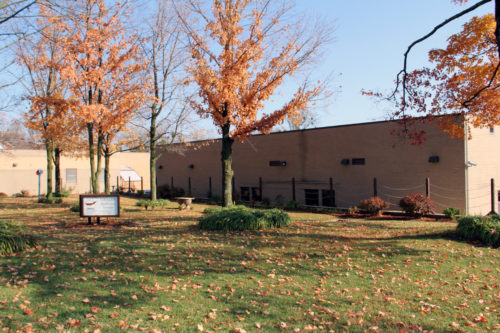Prison storytelling project transforms lives, educates the communityPosted Dec 5, 2013 |
|

The women inmates entered and exited the correction center’s multipurpose room single file with hands crossed behind their backs for the inside performance of Stories from the Inside Out. Among two women’s prisons and community correction centers, 17,259 women are incarcerated in Arkansas, according to the state Department of Correction. Photo: Lynette Wilson/ENS
[Episcopal News Service — Fayetteville, Arkansas] The words coming from the mouths of the five actors can be difficult to hear. It’s not the profanity, of which there isn’t much; it’s the descriptions of neglect, abuse, abandonment, addiction and loss experienced by 12 incarcerated women that weigh heavily on listeners.
It’s words like those used by a woman reflecting on her sister’s suicide: the bloodied wall; the couch left curbside for trash pickup. All that’s left of a life.
Or those of the mother who upon exiting a sweat-soaked bed needs to lock herself in the bathroom and find an uncollapsed vein to inject meth into before she can tend to the children hungry for breakfast and desperate for her attention.
They are the words of women who, twice a week for four months, worked with storytellers, poets, songwriters and artists to tap into dark crevices, to access the parts of themselves and their childhood memories that house the pain and suffering both endured and committed, and put it all on paper.
In mid-November, the actors read the women’s words for some 230 people gathered at St. Paul’s Episcopal Church in Fayetteville, Arkansas. It was the third time the Northwest Arkansas Prison Story Project staged a performance of “Stories from the Inside Out” at St. Paul’s, which adopted the project in 2012. The day before, on Nov. 14, the actors staged a reading for the 12 women who participated in the project’s third round and for their fellow inmates inside the community correction center.
Kathy McGregor, the project’s director, brought the storytelling project to Fayetteville in 2011 from Memphis, Tennessee, where a fellow nurse and storyteller, Elaine Blanchard, started a prison storytelling project in Shelby County.
“There’s power in story and a particular power in learning to tell your own story and having it told back to you,” McGregor said.

Kathy McGregor, director of the Northwest Arkansas Prison Story Project, presents a certificate to one of 12 storytellers following the inside performance of Stories from the Inside Out on Nov. 14 at the Northwest Arkansas Community Correction Center in Fayetteville. Photo: Lynette Wilson/ENS
Over the four-month period in preparing a show, themes begin to develop out of life-mapping exercises, poetry-writing prompts, songs and other readings. The women’s writing is then edited down to performance length.
Mothers and children were discussed a lot, and the women wanted to go deeper, exploring their own and other’s stories, said writing director Katie Nichol. She earned a Master of Fine Arts degree from the University of Arkansas, came to the storytelling project in July 2012 as a visiting artist and stayed.
“Sometimes it can be really hard when you hear stories full of pain,” said Nichol. “And then you can bring in a poem and watch them go from not understanding analyzing it on a college level.”
An ‘inside’ performance
The Northwest Arkansas Community Correction Center housing the participants resembles a convalescent home, the low-rise building sitting at the intersection of Spring Street and College Avenue in downtown Fayetteville, a college town. The 100 women living there, 97 percent of them white, all are serving time after being convicted of nonviolent crimes. Most, if not all, have one thing in common: emotional, physical or sexual abuse, or a combination of abuses and neglect.
“They come up real hard,” said McGregor. “Every city has a way of coming up hard, but Arkansas has rural hard.”
Before the center performance began, the actors ran through their lines in a small room off the side of the multipurpose room where the inmates later gathered. The 12 woman whose stories were being told practiced the song “Broken” with musician Shannon Wurst.
“I’m stronger than I thought I was,” said “Zaria Ezra” (each of the women receives a “stage name” for confidentiality), 25, serving her ninth month on a probation violation related to previous drug charges. “I’ve gone through a lot.”
The child of divorced parents, Zaria Ezra said she had survived abandonment, a 19-year-old boyfriend’s deadly drug overdose and a self-sabotaging approach to relationships with men after his death. “I’d get rid of them before they’d get rid of me,” she said during an interview in the practice room.
Zaria Ezra hopes to transition out of the center before Christmas. She plans to return to her family in Bentonville, the headquarters of Walmart, begin rebuilding relationships and work as a cosmetologist while undergoing chemotherapy to treat the Hepatitis C she contracted through intravenous drug use.
The prison stories project, she said, helped her free herself from the “mental bondage” associated with hiding herself from others.
“I’m not hiding now, I’m telling everyone my story,” she said. “It’s helped me be more confident in myself. I don’t have to hide.”
Before the performance, the inmates, all wearing yellow prison scrubs, entered single file, wrists crossed at the small of their backs, walking into the light-gray, low-ceiling cinderblock room in the correction center’s basement. They talked while Sugarland’s “Settlin’” played in the background: “I ain’t settling for anything less than everything.” When the chairs ran out, the women crossed the hall, bringing back enough chairs to add three more rows.
Then came the count – one, two, three, four – each woman sitting down after counting off, until the last woman called out, “92.” Then two more women scrambled in. A man radioed in the final count. Six women would miss the performance; some were on work duties, and others may have been sick, said Gary Tabor, the assistant warden.
Throughout the performance, one could see the influence of poetry, from “all I know fits into a 100cc syringe” to Carol Ann Davis’s poem “All You Know” to “Town of my Return” by Allison Seay.

Actors Chelsye Ginn, Jonny Schremmer, Laura Shatkus, Whitney Masters and Jocelyn Morelli during the inside performance of Stories from the Inside Out. Photo: Lynette Wilson/ENS
The 12 storytellers sat together during the reading. Sniffles from the storytellers, their fellow inmates, the correction center’s staff and guests, kept pace with the musical score. When it was over, the 94 women exited the room the same way they came in, single file, writs crossed at the small of their backs.
Tabor praised the storytelling project for its positive impact on participants.
In evaluation forms after the Nov. 14 program, some of the participants confirmed his assessment.
“It helped me realize I’m a survivor,” said one woman.
“It helped me get out some resentments that I have been harboring for years,” said another. “Writing is a great coping skill.”
She would recommend the project to others, she continued, “because it will ask them to cope with the harsh realities that drove them to drugs and other addictions in the first place. So that maybe they will stay away from that lifestyle.”
The story project fits with Warden Maggie Capel’s philosophy for the community correction center, which, unlike a tougher prison, focuses on making a difference in the inmates’ lives and helping them transition back into society.
“They are all quite moved by it,” said Capel, of the inside reading. “It’s very eye-opening to them to hear their story told by a third party.”
It also can be eye-opening for “outside” listeners.

Portraits of the 12 storytellers taken by photographer Andrew Kilgore hung on the wall at St. Paul’s Episcopal Church during the outside performance and were set on wooden easels behind the actors during the inside performance. Photo: Lynette Wilson/ENS
The play bill distributed the following evening at St. Paul’s explained the event’s intent: Everyone has a story, and when people are given the opportunity to listen to the stories of others, we become less likely to dehumanize one another with stereotypes.
This show was not as brutal as the last two; it’s more nuanced, said Erika Wilhite, the project’s theater director.
“It’s maybe one of the best ones yet,” she said. “The biggest job is not to allow melodrama; if it’s too graphic, the audience will draw back.”
The St. Paul’s performance had two objectives, McGregor said: to help people realize that under different circumstances the women’s stories could be their own and to show them that the journey that culminates in prison didn’t happen in a vacuum and that there are consequences to abuse. Click here to view the full performance, intended for mature audiences, at St. Paul’s.
In the 1950s, when family was sacred and McGregor was growing up in Auburn, Alabama, abuse wasn’t discussed, she said. Today, it’s discussed but still happens.
But the affected women don’t see themselves as victims, nor do they necessarily immediately see the connection between their childhood abuse and the decisions they made that led to their incarceration, McGregor said.
In some ways, she said, the storytelling project is an “exploration” – “What did happen differently for me?”
The November performances also provided an opportunity for reflection for actor Laura Shatkus, a Chicago native working on a master’s degree at the University of Arkansas. Looking at her childhood in comparison to the women’s, “had I made different decisions, or had different parents,” she said, their stories could have been hers.
Transitioning from incarceration
Working successively with three groups of inmates, McGregor and other volunteers involved in the project have identified a need beyond the storytelling.
“We’ve fallen in love three times with 36 women, we become so close,” said McGregor. “Some of the women have come from very abusive situations and have nowhere to go but back to the abusive situation. We’ve lost some to meth and alcohol addiction.”
So the next step in St. Paul’s prison ministry is to provide a transitional home where the women can live upon release from prison while they put their lives back together.
To stress the need for a transitional home, McGregor shared the story of a former story project participant, a gifted songwriter, who succumbed to her addictions.
In vivid, dry detail, the woman, who grew up without electricity and running water, recalled how it felt when her mother grabbed her hair with such force that her scalp separated from her skull; how hard it was to run and keep up with her siblings while wearing two left shoes; and the years of sexual abuse she endured by an older brother, until the day she cried and he stopped.
The woman, in her 20s and with three children of her own, was paroled and returned to that same family environment and eventually returned to her drug addiction, McGregor told ENS during a sit-down interview at a coffee shop in Fayetteville.
“That is why I want a halfway house,” said McGregor.
It’s a subject that hits close to home.
“I don’t know why I didn’t end up in prison,” said McGregor, a longtime storyteller, parish nurse and union organizer who now works as a hospice nurse at a nearby Veterans Administration Hospital. “I survived terrible abuse.”
McGregor’s mother and stepfather both were abusive, while her biological father was absent, she said. It was through therapy that she “dug deep” into her own childhood, later becoming angry with her father and not speaking with him for a few years.
“Where is the space to process when you come back to the same situation?” she asked.

Northwest Arkansas Community Correction Center is located at the intersection of Spring Street and College Avenue in downtown Fayetteville. Photo: Lynette Wilson/ENS
St. Paul’s has included seed money for the transitional home in its 2014 stewardship campaign. In October, McGregor, Nichol and the Rev. Suzanne Stoner, a priest associate at St. Paul’s, attended the first national Thistle Farms Conference in Nashville, Tennessee, to network with others who work with similar populations of women and to learn how to operate a home.
“This is not a transitional house, this is a moment in a movement,” said Stoner, who is a regular celebrant, along with the Rev. Lowell Grisham, with St. Paul’s rector, during a weekly Eucharist inside the correction center.
The congregation’s response to the story project has been positive, said Grisham, though he said he’d been underwhelmed with its attendance at the performances.
“There’s reluctance and intimidation when we are faced with something profound and terrible,” he said.
To which Stoner added, “You have to be willing to have your eyes opened.”
For parishioner Debbie Griffin, a licensed professional counselor who works at an alternative high school, the stories of the women are the stories of the teenagers she serves, many of whom are parents themselves.
Part of her work, she said, is “undoing the damage and breaking the pattern that has been perpetrated on them by their family and circumstances.
“It’s hard to overcome that,” she said. “They are victims of something bigger than themselves … abuse being the common thread.”
“Essence,” 28, another storyteller, suffered physical and mental abuse at the hands of her mother, single and an alcoholic, and grew up in foster care. Taking part in the storytelling project helped her overcome a lot of issues, she said.
“By sharing it and writing it down, I don’t have to live it anymore,” she said. “Every choice I made was based on my childhood.”
A parole revocation brought Essence to the corrections center. She said she expected to be released in March, when she planned to reunite with her children, a 5-year-old son and a 9-year-old daughter, who currently live with her mother, who’s still drinking “but not as much,” in Mississippi. Essence will bring the children back to Arkansas.
“It felt good, like an accomplishment,” said Essence following the inside reading. “I have the motivation to do what I’ve got to do now.”
— Lynette Wilson is an editor and reporter for the Episcopal News Service.

Social Menu